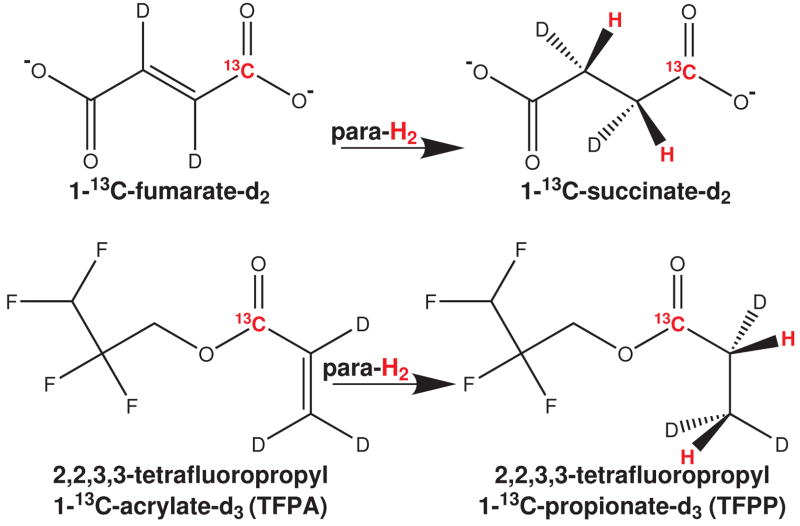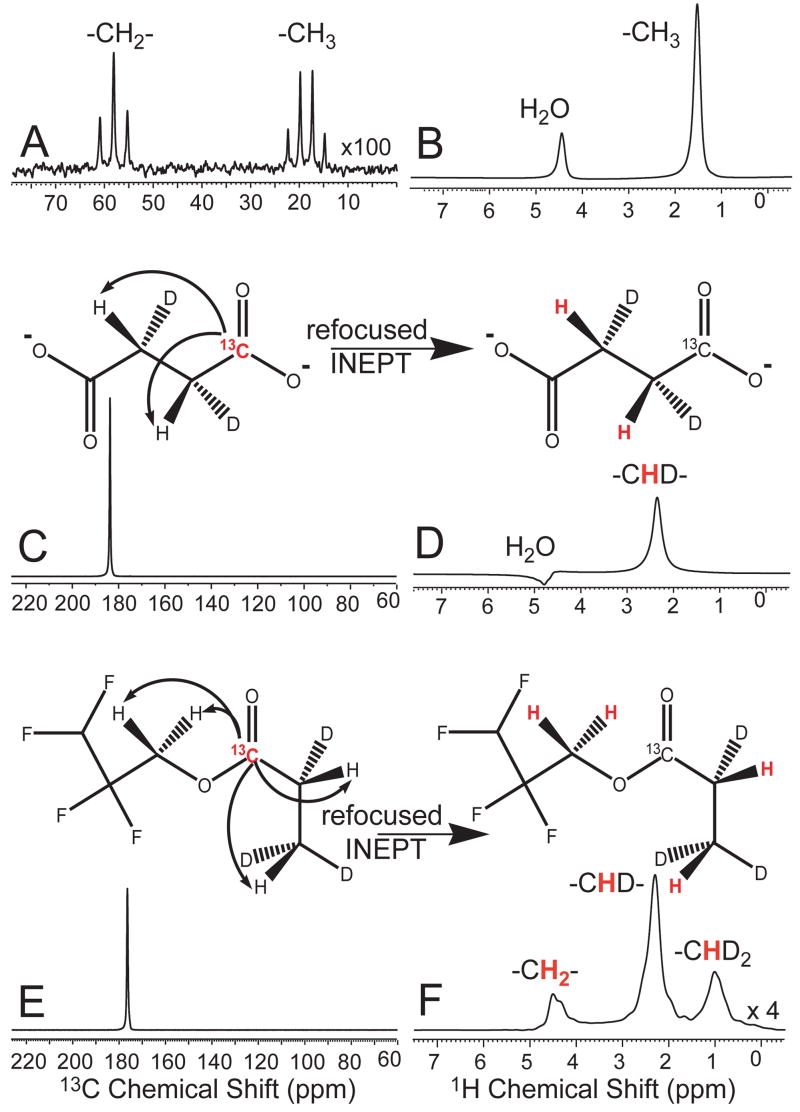Abstract
Here, we demonstrate the utility of low gamma nuclei for spin storage of hyperpolarization followed by proton detection, which theoretically can provide up to ~(gamma[1H]/gamma[X])2 gain in sensitivity in hyperpolarized biomedical MR. This is exemplified by hyperpolarized 1-13C sites of 2,2,3,3-tetrafluoropropyl 1-13C-propionate-d3 (TFPP), 13C T1=67 s in D2O, and 1-13C-succinate-d2, 13C T1=105 s in D2O, pH 11, using PASADENA. In a representative example, the spin polarization was stored on 13C for 24 s and 70 s respectively while the samples were transferred from a low magnetic field polarizer operating at 1.76 mT to a 4.7 T animal MR scanner. Following sample delivery, the refocused INEPT pulse sequence was used to transfer spin polarization from 13C to protons with efficiency of 50% for TFPP and 41% for 1-13C-succinate-d2 increasing the overall NMR sensitivity by factor of 7.9 and 6.5 respectively. The low gamma nuclei exemplified here by 13C with T1 of tens of seconds acts as an efficient spin polarization storage, while J-coupled protons are better for NMR detection.
The PASADENA (parahydrogen and synthesis allow dramatically enhanced nuclear alignment)1,2 and DNP (Dynamic Nuclear Polarization)3 methods efficiently hyperpolarize biologically relevant nuclei such as 1H, 31P, 13C, 15N achieving the signal enhancement by factor of ~100,000 on currently utilized MRI scanners. Recently, many groups have demonstrated the utility of hyperpolarized MR in biological systems using hyperpolarized 13C biomarkers with relatively long spin lattice relaxation time T1 on the order of tens of seconds.4–7 Moreover, hyperpolarized 15N for biomedical MR has been proposed due to even longer spin lattice relaxations times.8 An additional increase of up to tens of minutes in the life time of hyperpolarized agent in vivo could be achieved by using the singlet states of low gamma (γ) nuclei.9 However, as NMR receptivity scales as γ3 for spin ½ nuclei, direct NMR detection of low γ nuclei results in lower signal-to-noise ratio compared to proton detection. While protons are better nuclei for detection, short spin lattice relaxation times prevent direct 1H hyperpolarized MR in biomedical applications.
Here, we demonstrate the utility of 13C for spin storage of hyperpolarization followed by 1H detection using INEPT,10 which theoretically can provide up to ~(γ1H/γX)2 gain in sensitivity in hyperpolarized biomedical MR. Specifically, we hyperpolarized the 13C site of two well studied molecules, 1-13C-succinate-d25,11 and 2,2,3,3-tetrafluoropropyl 1-13C-propionate-d3 (TFPP), by PASADENA (Fig. 1). Both molecules are accessible from unsaturated precursors containing a double bond by molecular cis addition of parahydrogen. Hyperpolarized succinate5,11 can be potentially exploited as a metabolic biomarker of cancer, while hyperpolarized TFPP has been shown to be a specific binder to lipids with an unique chemical shift signature in the lipid bound state12 potentially useful for plaque imaging.13
Figure 1.
Cis molecular addition of parahydrogen to 1-13C-fumarate-d2 to produce 1-13C-succinate-d2 and cis molecular addition of parahydrogen to TFPA to produce TFPP. The catalytic reaction was carried out at 60°C in D2O with reactant concentrations of 3–6 mM. TFPP aqueous solution used 10% v/v acetone-d6 necessary to dissolve hyperpolarized product.
Parahydrogen addition and transfer of spin order to 13C has been described previously.5,14 A home built PASADENA polarizer was employed to hydrogenate 2,2,3,3-tetrafluoropropyl 1-13C-acrylate-d3 (TFPA) to yield hyperpolarized TFPP and 1-13C-fumarate-d2 (CIL, Andover, MA) to yield hyperpolarized 1-13C-succinate-d2 in deuterated solvent. The spin order transfer was performed using untuned saddle coil at 1.76 mT utilizing the heteronuclear spin order transfer pulse sequence described by Goldman and Johannesson15 and was tailored to the hetero- and homonuclear J coupling of propionate14,16 for TFPP and succinate at pH 11 (Fig. 2).5
Figure 2.
The experimental diagram of molecular cis addition of parahydrogen followed by hyperpolarization of X nucleus exemplified by 13C, polarization storage on X nucleus (potentially allowing monitoring of biochemical events on the time scale of minutes) followed by polarization transfer back to more sensitive protons for NMR detection.
In vitro 1-13C succinate spin lattice relaxation time T1 is 105±1 s in D2O at pH 11 and in vivo T1 is in excess of 43 s at 4.7 T, which is significantly longer than the previously published values at pH 3.5 In vitro 1-13C TFPP T1=67±1 s in deuterated medium and in vivo T1 is in excess of 16 s at 4.7 T.13 Such long spin lattice relaxation times provide an efficient storage of spin polarization in long lived low γ nuclear spin states, which is exemplified here by 13C TFPP and succinate. The principal motivation for development of long lived nuclear spin states is their utility to monitor biochemical pools in vivo such as stable isotope enrichment of metabolic events or receptor binding. NMR signal detection utilizing polarization transfer from long lived low γ nuclear spin states to J-coupled protons provides a potential to further increase MR signal in such studies (Fig. 2) utilizing the strategy of two sequential polarization transfers.17
In one experiment, 2.4 mL of 6.2 mM 1-13C-succinate-d2 was hyperpolarized at the 13C site to 10.7%. Hyperpolarization was then kept on 13C for 70 s. During this time, the polarized sample was transferred from a low magnetic field polarizer operating at 1.76 mT to 4.7 T animal MR scanner. The 13C polarization decayed from 10.7% to 5.5% corresponding to final 13C signal enhancement by a factor of 13,500. Then the refocused INEPT pulse sequence10 with τINEPT = 34 ms and τrefocus = 32 ms (Fig. 2) was used to transfer polarization from 13C to protons within 1-13C-succinate-d2 (Figs. 3A and 3B). We found that the two protons were successfully hyperpolarized corresponding to 41% polarization transfer efficiency and 1,350 fold 1H NMR signal enhancement per two methylene protons. In a separate experiment, 2.4 mL of 2.9 mM TFPP was polarized to 14% and the hyperpolarization was stored on the 1-13C site for 24 s, during which the polarization decayed to 9.5% corresponding to the final signal enhancement of 23,300 fold at this site (Fig. 3E). The delays of the refocused INEPT were τINEPT = 20 ms and τrefocus = 16 ms. The combined intensity of the three NMR lines corresponding to four hydrogen atoms (Fig. 3F) was enhanced by a factor of 2,930, corresponding to the 50% polarization transfer efficiency by the refocused INEPT sequence.
Figure 3.
A) 13C reference spectrum of 2.8 mL 17M ethanol with 188 mM 13C concentration per site, B) 1H NMR spectrum of 2.8 mL 3M sodium 13C-acetate in D2O, C) 13C NMR spectrum of hyperpolarized 6.2 mM 1-13C-succinate-d2,3, 13C polarization of 5.5% after being stored for 70 s, T1=105 s, the spectrum is acquired using a 12° excitation pulse, D) 1H NMR spectrum of hyperpolarized 6.2 mM 1-13C-succinate-d2,3 where net 1H signal enhancement is 1,350 fold with 41% spin polarization transfer efficiency, E) 13C NMR spectrum of hyperpolarized 2.9 mM TFPP. 13C polarization is 9.5% after being stored for 24 s, T1=67 s. The spectrum is acquired using a 12° excitation pulse, F) 1H NMR spectrum of hyperpolarized 2.9 mM TFPP where net 1H signal enhancement is 2,930 fold with 51% efficiency.
To quantify the degree of hyperpolarization, we used the reference of a single scan spectrum of thermally polarized 100% natural abundance ethanol (Fig. 3A) and 3M sodium 1-13C-acetate (Fig. 3B) at 4.7 T using the formula:
where is the nuclear polarization at equilibrium at 298 K and 4.7 T, according to the Boltzmann distribution, θ is the angle of the detection pulse, χref and χexpt are the molar concentrations of sites in the reference and the experimental molecule, respectively, and Sref and Sexpt are the signal from the reference and experimental molecular sites, respectively. Under the experimental conditions, is 246,600−1 and is 62,000−1. The achieved %P1H was 2.2% for 1-13C-succinate-d2 and 4.8% for TFPP. The efficiency of the polarization transfer from 13C to 1H reported here, 41% for 1-13C-succinate-d2 and 50% for TFPP, is a ratio between the 1H polarization detected after the transfer and 13C polarization as measured by a 12° excitation pulse before the INEPT transfer. While the efficiency of the polarization transfer was 50% or below, hyperpolarized protons are inherently 15.8 fold more sensitive compared to hyperpolarized 13C. As a result, proton detection of hyperpolarized 1-13C-succinate-d2 and TFPP increased the overall sensitivity by a factor of 6.5 and 7.9, respectively.
The method demonstrated herein can potentially be applied to these and other hyperpolarized 13C metabolic contrast agents in vivo including hyperpolarized pyruvate,18 lactate, bicarbonate,6 alanine, glutamine,7 choline.8 More importantly, using this approach, hyperpolarized 15N MR would become an attractive biomedical tool due to the much longer spin lattice relaxation time owing to low γ, but now with the added advantage of more sensitive detection using proton NMR (γ215N ≈ γ21H/100). Furthermore, proton imaging, localized spectroscopy and chemical shift imaging (CSI) will allow improved spatial resolution by γ1H/γX in each dimension at a given gradient strength.
Acknowledgments
We thank the following for funding: NIH 1K99CA134749-01, R01 CA 122513, 1R21 CA118509, Rudi Schulte Research Institute, James G. Boswell Fellowship, AHA, American Brain Tumor Association, Beckman Institute, Tobacco Related Disease Research Program 16KT-0044, Prevent Cancer Foundation.
References
- 1.Bowers CR, Weitekamp DP. Phys Rev Lett. 1986;57:2645–2648. doi: 10.1103/PhysRevLett.57.2645. [DOI] [PubMed] [Google Scholar]
- 2.Bowers CR, Weitekamp DP. J Am Chem Soc. 1987;109:5541–5542. [Google Scholar]
- 3.Abragam A, Goldman M. Rep Prog Phys. 1978;41:395–467. [Google Scholar]
- 4.Golman K, in’t Zandt R, Thaning M. Proc Natl Acad Sci U S A. 2006;103:11270–11275. doi: 10.1073/pnas.0601319103. [DOI] [PMC free article] [PubMed] [Google Scholar]
- 5.Chekmenev EY, Hovener J, Norton VA, Harris K, Batchelder LS, Bhattacharya P, Ross BD, Weitekamp DP. J Am Chem Soc. 2008;130:4212–4213. doi: 10.1021/ja7101218. [DOI] [PMC free article] [PubMed] [Google Scholar]
- 6.Gallagher FA, Kettunen MI, Day SE, Hu DE, Ardenkjaer-Larsen JH, in’t Zandt R, Jensen PR, Karlsson M, Golman K. Nature. 2008;453:940–U973. doi: 10.1038/nature07017. [DOI] [PubMed] [Google Scholar]
- 7.Gallagher FA, Kettunen MI, Day SE, Lerche M, Brindle KM. Magn Reson Med. 2008;60:253–257. doi: 10.1002/mrm.21650. [DOI] [PubMed] [Google Scholar]
- 8.Gabellieri C, Reynolds S, Lavie A, Payne GS, Leach MO, Eykyn TR. J Am Chem Soc. 2008;130:4598–4599. doi: 10.1021/ja8001293. [DOI] [PubMed] [Google Scholar]
- 9.Pileio G, Carravetta M, Hughes E, Levitt MH. J Am Chem Soc. 2008;130:12582–12583. doi: 10.1021/ja803601d. [DOI] [PubMed] [Google Scholar]
- 10.Morris GA, Freeman R. J Am Chem Soc. 1979;101:760–762. [Google Scholar]
- 11.Bhattacharya P, Chekmenev EY, Perman WH, Harris KC, Lin AP, Norton VA, Tan CT, Ross BD, Weitekamp DP. J Magn Reson. 2007;186:150–155. doi: 10.1016/j.jmr.2007.01.017. [DOI] [PMC free article] [PubMed] [Google Scholar]
- 12.Chekmenev EY, Chow SK, Tofan D, Weitekamp DP, Ross BD, Bhattacharya P. J Phys Chem B. 2008;112:6285–6287. doi: 10.1021/jp800646k. [DOI] [PMC free article] [PubMed] [Google Scholar]
- 13.Chekmenev EY, et al. Towards Receptor Targeted13C Hyperpolarized MR Biosensors. Angew Chem Int Ed. submitted. [Google Scholar]
- 14.Bhattacharya P, Harris K, Lin AP, Mansson M, Norton VA, Perman WH, Weitekamp DP, Ross BD. Magn Reson Mat Phys Biol Med. 2005;18:245–256. doi: 10.1007/s10334-005-0007-x. [DOI] [PubMed] [Google Scholar]
- 15.Goldman M, Johannesson H. C R Physique. 2005;6:575–581. [Google Scholar]
- 16.Goldman M, Johannesson H, Axelsson O, Karlsson M. C R Chimie. 2006;9:357–363. [Google Scholar]
- 17.Aime S, Gobetto R, Reineri F, Canet D. J Chem Phys. 2003;119:8890–8896. [Google Scholar]
- 18.Golman K, in’t Zandt R, Lerche M, Pehrson R, Ardenkjaer-Larsen JH. Cancer Res. 2006;66:10855–10860. doi: 10.1158/0008-5472.CAN-06-2564. [DOI] [PubMed] [Google Scholar]





